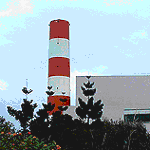Dioxin Improvement Work
 Neihu Incinerator (herein referred to as the Incinerator), an incinerator of the Department of Environmental Protection of Taipei City Government, is the first large-size modernized incinerator in the nation and in Taipei City. It is equipped with complete waste feeding, storage, incineration, energy recycling, power generation, and pollution control facilities. Since its test operation in January 1991, the Incinerator has been running for over 20 years. Its processing capability, particularly in the areas of conventional air pollutant control and power generation efficiency, is in good condition. Furthermore, the Incinerator has a lot of public facilities (e.g. indoor swimming pool, activity center and tennis court), which is a benchmark of community relations and exemplary model for other incinerators in Taiwan. In fact, it has an irreplaceable significance in Taiwan's waste incineration history. However, due to the early design and planning of the Incinerator, plus changes in social economic conditions, there is increasing requirement for environmental protection, which presents different kinds of issues and challenges for the Incinerator. For instance, according to the Dioxin Control and Emission Standard for Incinerators established by the EPA on August 6, 1997, the Incinerator was requested to reduce the concentration of dioxin emission to 1.0 ng-TEQ/N m3 or below within four years. Then on October 6, 1999, a more stringent standard was announced, requesting the Incinerator to reduce the concentration of dioxin emission to 0.1 ng-TEQ/N m3 or below by August 8, 2001. Furthermore, in the Management Method and Facility Standard for Ordinary Waste, first promulgated on April 23, 1997, it was requested that fly ash and bottom ash be collected and stored separately. As the Incinerator's existing pollution control facilities are unable to meet the stipulations of the new regulations, in order to ensure effective waste management and to comply with new regulations for pollutant emission, the Incinerator has to upgrade part of its facilities. In addition, some of the related equipment is unable to meet requirements of new facilities due to their obsolete design or insufficient capacity. The Incinerator is actively drafting a plant improvement plan. In February 1999, it halted plant operation to conduct dioxin improvement work and related operations. A test-run is scheduled for the end of 2000 and all improvements are expected to be completed in March 2001. The large-scale upgrade work currently implemented by the Incinerator is unprecedented for the first large-size incinerator in Taiwan. The related experience, technology and data will set a benchmark for planning to improve pollution facilities and extend life span of many old large-size incinerators. We believe that, after the improvement, the Incinerator's commitment and effort in environmental protection will bring residents of Taipei City a cleaner and more comfortable living space.
Neihu Incinerator (herein referred to as the Incinerator), an incinerator of the Department of Environmental Protection of Taipei City Government, is the first large-size modernized incinerator in the nation and in Taipei City. It is equipped with complete waste feeding, storage, incineration, energy recycling, power generation, and pollution control facilities. Since its test operation in January 1991, the Incinerator has been running for over 20 years. Its processing capability, particularly in the areas of conventional air pollutant control and power generation efficiency, is in good condition. Furthermore, the Incinerator has a lot of public facilities (e.g. indoor swimming pool, activity center and tennis court), which is a benchmark of community relations and exemplary model for other incinerators in Taiwan. In fact, it has an irreplaceable significance in Taiwan's waste incineration history. However, due to the early design and planning of the Incinerator, plus changes in social economic conditions, there is increasing requirement for environmental protection, which presents different kinds of issues and challenges for the Incinerator. For instance, according to the Dioxin Control and Emission Standard for Incinerators established by the EPA on August 6, 1997, the Incinerator was requested to reduce the concentration of dioxin emission to 1.0 ng-TEQ/N m3 or below within four years. Then on October 6, 1999, a more stringent standard was announced, requesting the Incinerator to reduce the concentration of dioxin emission to 0.1 ng-TEQ/N m3 or below by August 8, 2001. Furthermore, in the Management Method and Facility Standard for Ordinary Waste, first promulgated on April 23, 1997, it was requested that fly ash and bottom ash be collected and stored separately. As the Incinerator's existing pollution control facilities are unable to meet the stipulations of the new regulations, in order to ensure effective waste management and to comply with new regulations for pollutant emission, the Incinerator has to upgrade part of its facilities. In addition, some of the related equipment is unable to meet requirements of new facilities due to their obsolete design or insufficient capacity. The Incinerator is actively drafting a plant improvement plan. In February 1999, it halted plant operation to conduct dioxin improvement work and related operations. A test-run is scheduled for the end of 2000 and all improvements are expected to be completed in March 2001. The large-scale upgrade work currently implemented by the Incinerator is unprecedented for the first large-size incinerator in Taiwan. The related experience, technology and data will set a benchmark for planning to improve pollution facilities and extend life span of many old large-size incinerators. We believe that, after the improvement, the Incinerator's commitment and effort in environmental protection will bring residents of Taipei City a cleaner and more comfortable living space.

![Taiwan.gov.tw [ open a new window]](/images/egov.png)
